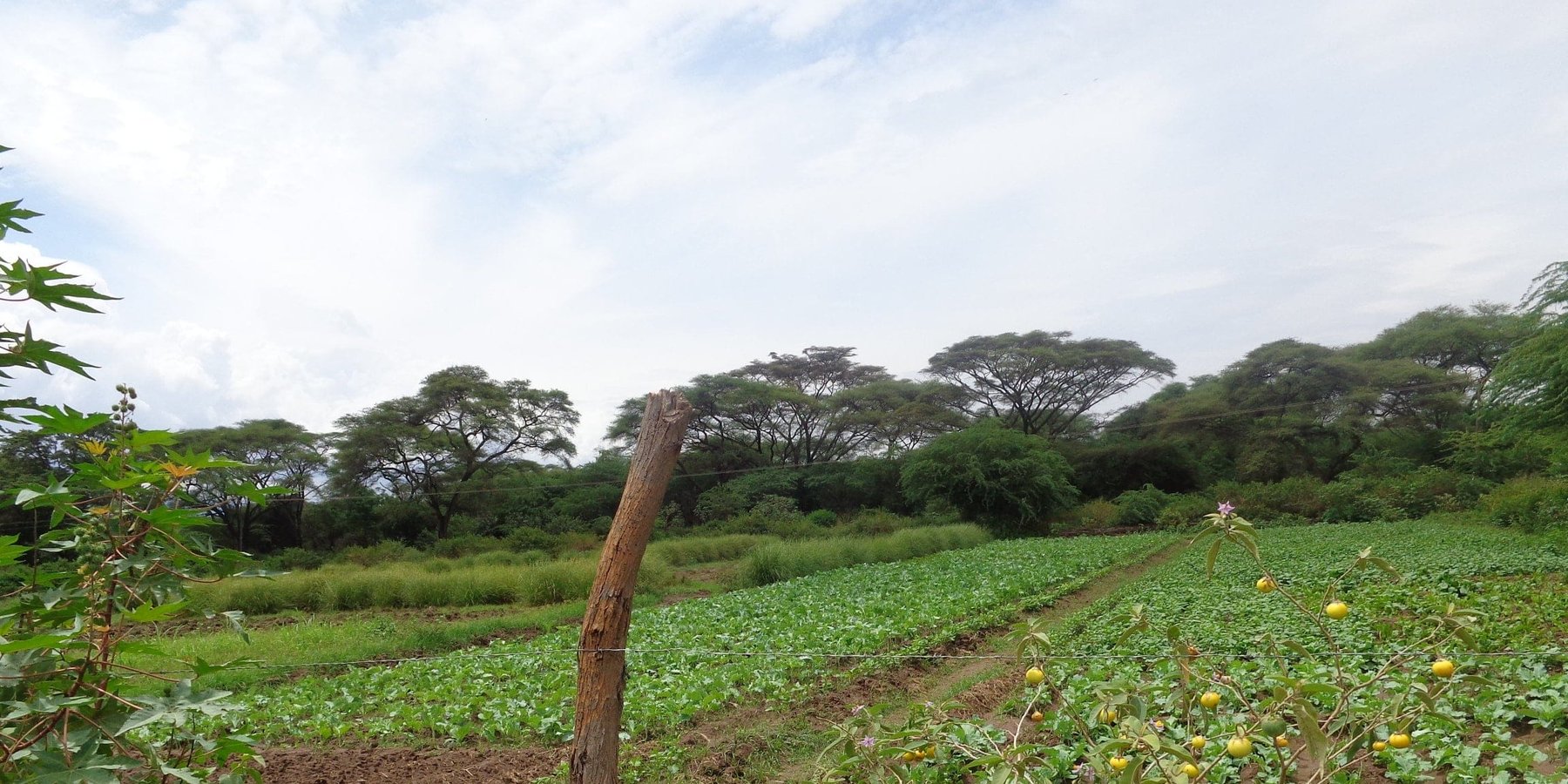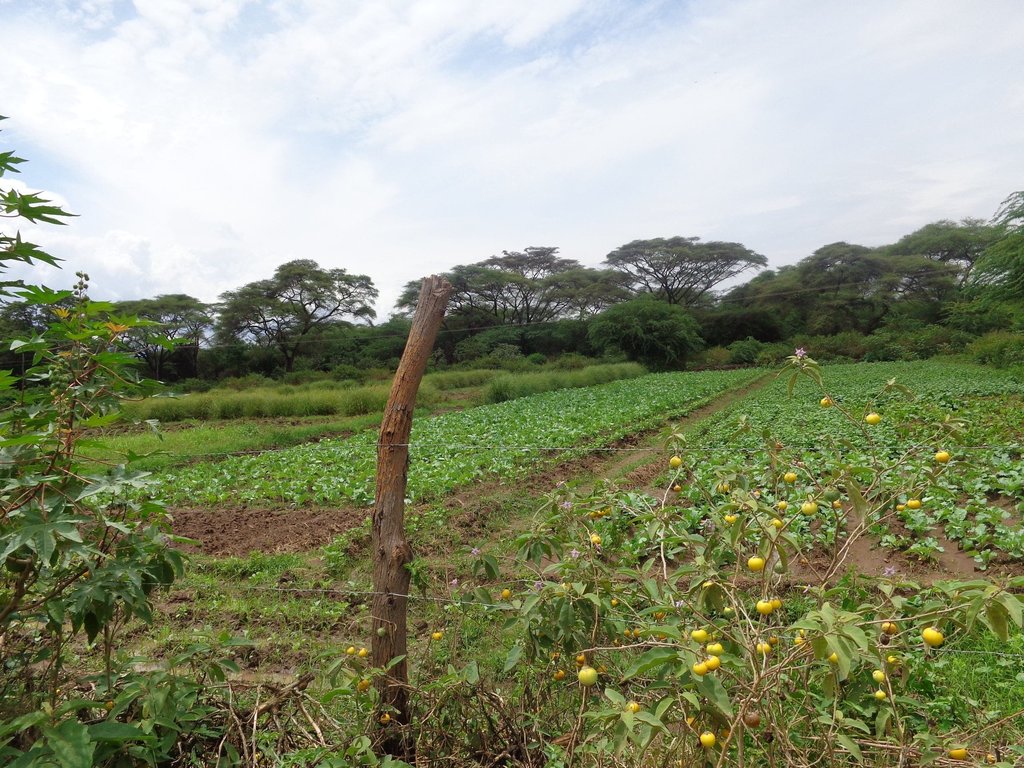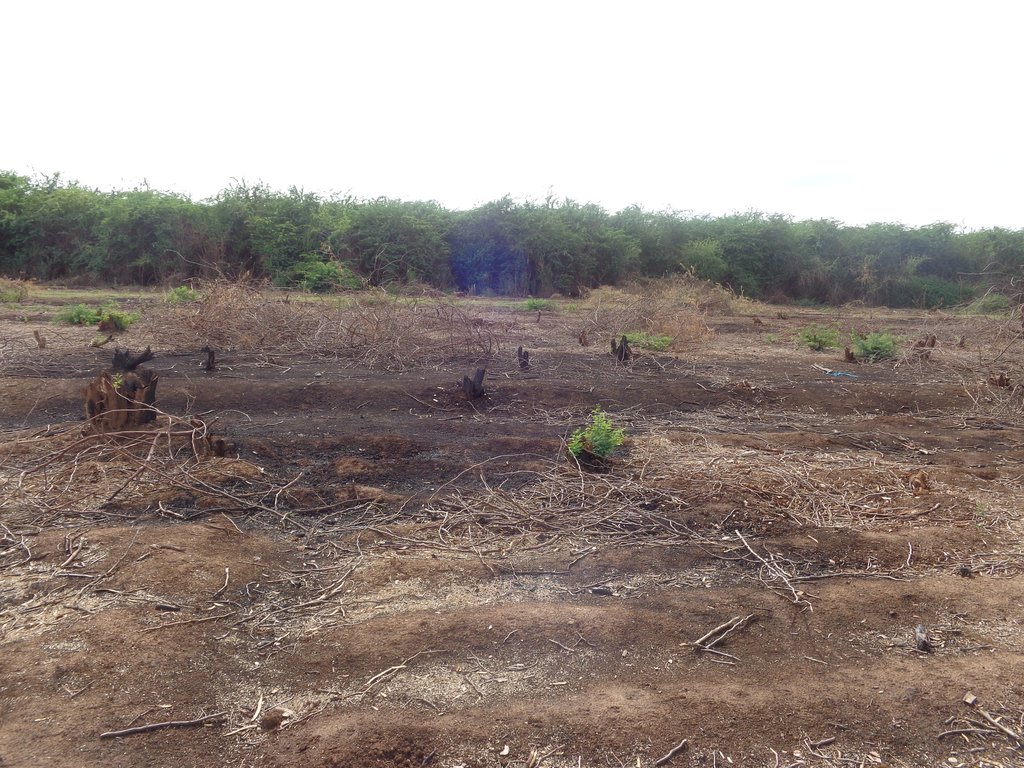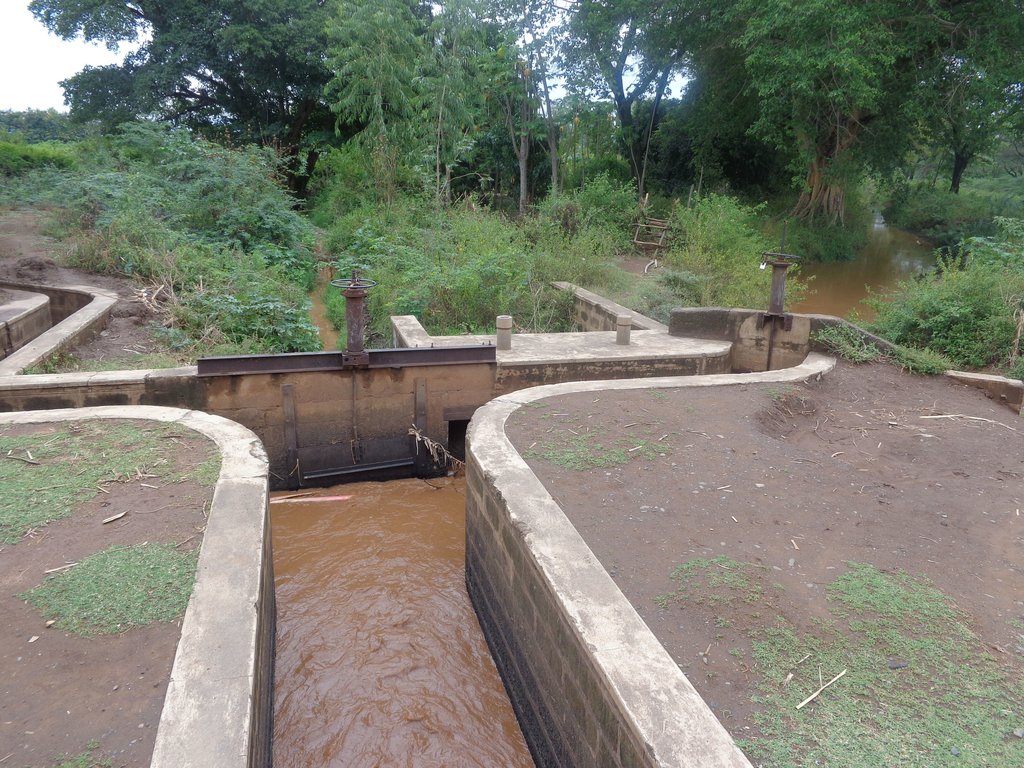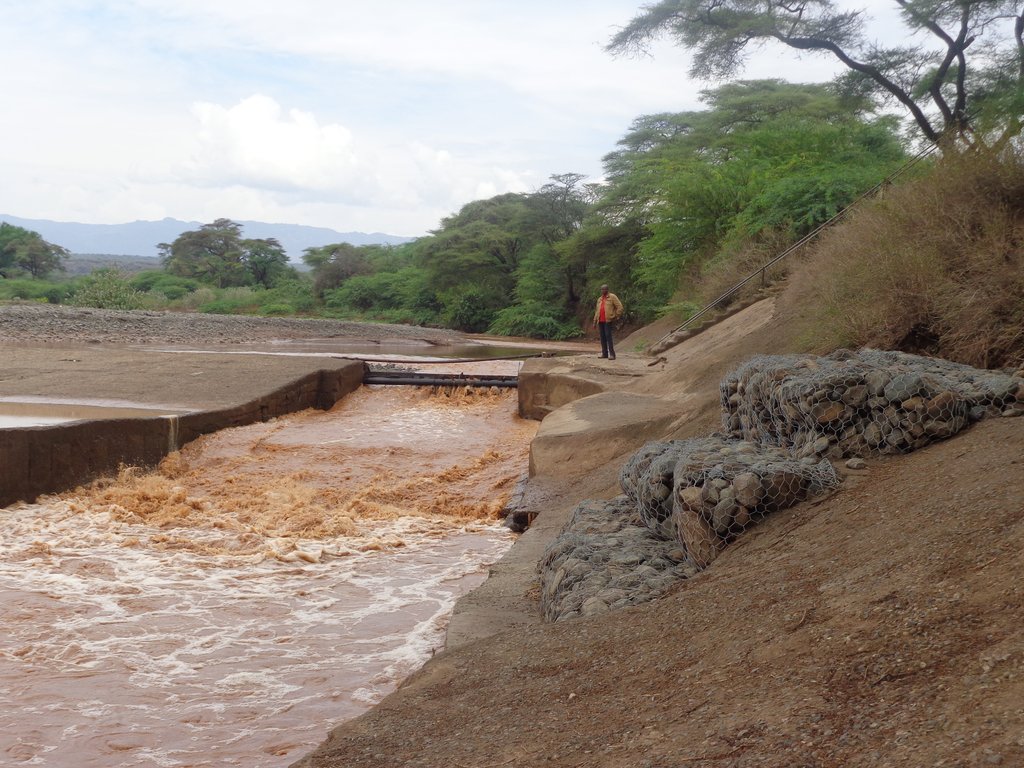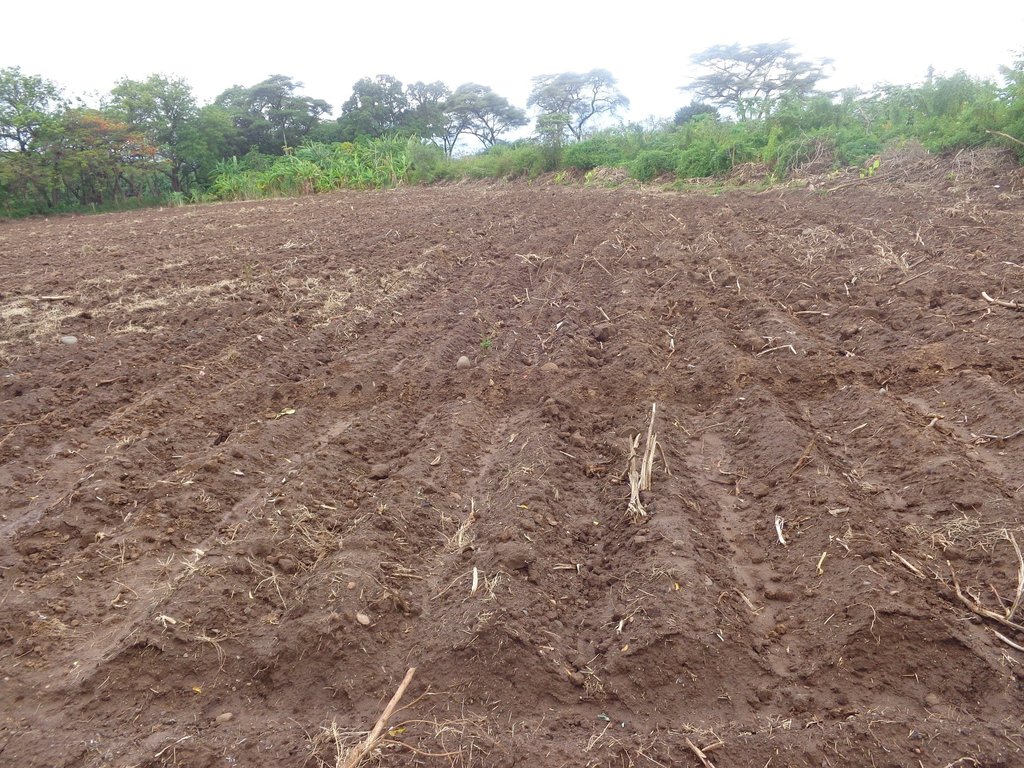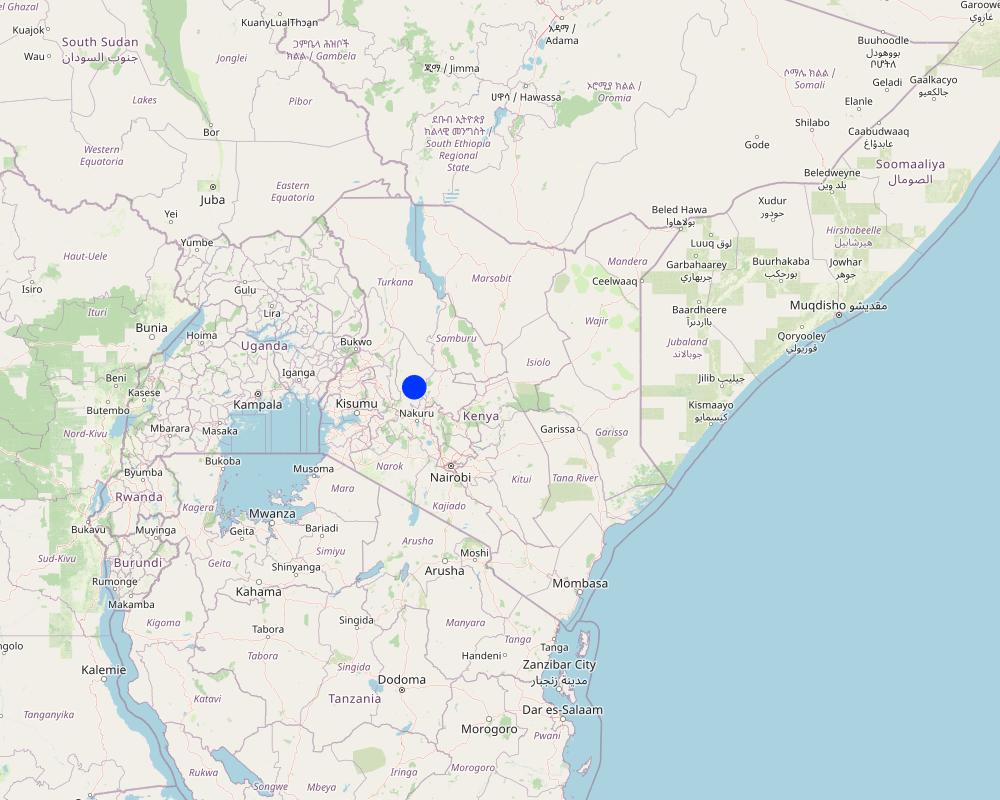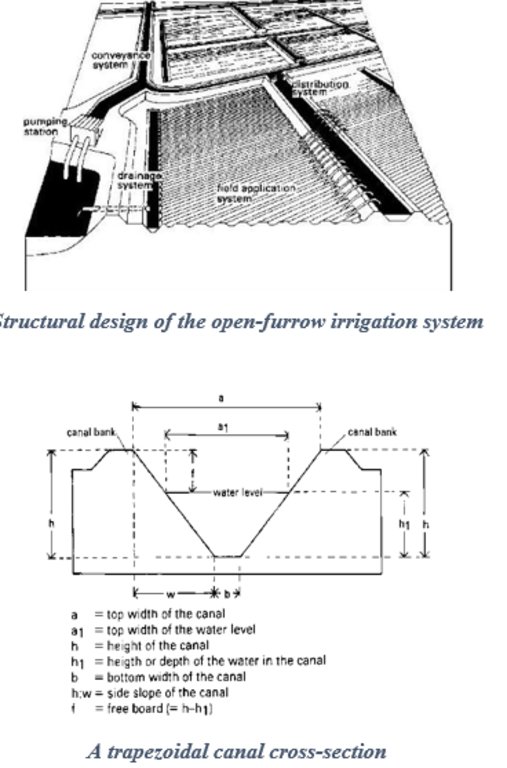Controlling invasive species by physical removal and crop cultivation through open fallow irrigation [Кени]
- Шинийг нээх:
- Шинэчлэх:
- Эмхэтгэгч: Beatrice Otieno
- Хянан тохиолдуулагчид: Urs Baumgartner, Christian Hergarten
- Хянагчид: Rima Mekdaschi Studer, Rene Eschen
Cut, Burn, Uproot and Cultivate
technologies_3444 - Кени
Бүлгүүдийг үзэх
Бүгдийг дэлгэх Бүгдийг хаах1. Ерөнхий мэдээлэл
1.2 Технологийг үнэлэх, баримтжуулах ажилд хамаарах мэдээлэл өгсөн хүмүүс, байгууллагуудын холбоо барих мэдээлэл
1.3 ВОКАТ-аар баримтжуулсан өгөгдлийг ашиглахтай холбоотой нөхцөл
Мэдээллийг хэзээ (газар дээр нь) цуглуулсан бэ?
14/03/2018
Эмхэтгэгч болон гол мэдээлэгч хүн(хүмүүс) WOCAT аргачлалаар баримтжуулсан мэдээллийг ашиглахтай холбоотой нөхцлийг хүлээн зөвшөөрсөн:
Тийм
1.4 Технологи тогтвортой гэдгийг баталгаажуулах
Энэ технологийг газрын доройтлыг бууруулж, газрын тогтвортой менежментийг хангахад тохиромжтой гэж үзэж болох уу?
Үгүй
Тайлбар:
Cultivation through irrigation in Perkerra scheme begun in 1954, three decades before the introduction of Prosopis in Baringo. Despite the rapid and widespread expansion of the invasive species, it is evident that cultivated areas under the scheme are free from Prosopis, unlike their surrounding neighborhoods which are heavily invaded and rendered unproductive. This is an indication of its sustainability to control Prosopis spread to irrigated land.
2. ГТМ Технологийн тодорхойлолт
2.1 Технологийн товч тодорхойлолт
Технологийн тодорхойлолт:
This is an open-furrow system consisting barriers constructed along a water source such as a river to direct water through a conveyance system by gravity into feeder channels to cultivated land. It is a simple method entailing control of water flow rate and direction to improve water utilization efficiency and enhance productivity of land.
2.2 Технологийн дэлгэрэнгүй тодорхойлолт
Тодорхойлолт:
Perkerra irrigation scheme was constructed by the colonial government in 1945 to ensure efficient water utilization, enhance soil productivity and food security. It is an open-furrow system consisting barriers constructed along a water source such as a river to direct water through a conveyance system by gravity into feeder channels to cultivated land. Water control system is constructed between the conveyance and the feeder channels to control the direction and speed of the water.
This technology is suitable on fairly flat, irrigable land with reliable water sources for irrigation. Consideration of population structure is crucial in ascertaining the availability labor force in farmlands. Depending on the size and market orientation of the production system, a stable market is also an important consideration.
Irrigated farming in the scheme is carried out in 3 seasons a year due to availability of reliable water from the permanent Perkerra River. This also ensures that land is never left idle for re-invasion of Prosopis. Activities commence with land clearance conducted at the beginning of every planting season. Prosopis on invaded farmlands are manually cut, burnt and uprooted to minimize chances of the invasive tree from coppicing. The uprooted trunk is utilized in charcoal production for commercial purposes while the small branches are used as firewood for domestic cooking.
The cleared land is then ploughed using a tractor to break the soil structure and provide a fine tilth for planting. This is followed by mechanized ridging to create channels and buffer furrows to convey and retain water long enough to be infiltrated into the soil. Seeds are then sown, a joint activity carried out through farmers’ cooperation. The scheme was originally specialized for bulb onions plantation but has transformed into more diversified food crops for subsistence and commercial purposes. Crops under contractual farming are seed maize, rice, sunflower, green grams, pepper and cow peas while surplus crops under irrigation include tomatoes, vegetables, water melons, subsistence maize crops and commercial fruit trees. In addition, availability of assured market and payment has made the scheme popular for seed maize cultivation. Ongoing experimental research on a variety sweet potatoes to reduce overdependence on maize crops have also shown promising results and are likely to be recommended for implementation. During planting seasons, fallow periods are replaced by rotational cropping and crop diversification. This improves soil structure by alternating deep and shallow-rooted crops. Replacement of the crop during rotation disrupts the life cycle of disease causing organisms, thus controlling pests and diseases as well as improving crop productivity. Consequently, there is minimal application of chemical pesticides, hence reduced chances of pollution.
The irrigated cultivation has improved the welfare of the community by diversifying their sources of livelihood from pastoralism, enhancing food security, eradication of poverty and improving infrastructure such as access roads to the farms. It is a major source of income, directly supporting 1,625 farm households earning an approximate total net income of Ksh. 148, 192,259 Million (Perkerra scheme brief prepared by the National Irrigation board, 2017). Each household is assigned between 0.5 to 4 acres of land. This range might however be narrowed in the near future due to the increasing population in demand for the fixed land resource. The other option under consideration is to reclaim more invaded land and expand the scheme. The challenge facing this approach and is yet to be addressed is limited water resources to sustain the expansion. Lack of suitable market for non-contractual crops as well as poor pricing due to monopolization by contracting institutions is also a great setback to this technology. A good example is the abandonment of pawpaw production by farmers due to marketing problems.
2.3 Технологийн гэрэл зураг
2.5 Энэ үнэлгээнд хамрагдсан технологийг хэрэгжүүлсэн улс орон/ бүс нутаг/ байршил
Улс:
Кени
Улс/аймаг/сум:
Baringo County
Байршлын дэлгэрэнгүй тодорхойлолт:
Marigat sub-couty
Map
×2.6 Хэрэгжсэн хугацаа
Байгуулсан тодорхой оныг мэдэхгүй бол баримжаа хугацааг тодорхойл:
- >50 жилийн өмнө (уламжлалт)
2.7 Технологийн танилцуулга
Технологийг хэрхэн нэвтрүүлснийг тодорхойл:
- Гадны төсөл/хөтөлбөрийн дэмжлэгтэйгээр
Тайлбар (төслийн төрөл г.м.):
The scheme was established during the colonial period through local detainees in Marigat. This followed a feasibility study pointing to the suitability of the IIchamus plain for agricultute,
3. ГТМ технологийн ангилал
3.1 Технологийн үндсэн зорилго (ууд)
- үйлдвэрлэлийг сайжруулах
- сав газрыг хамгаалах (усны эх/ голын адаг) - бусад технологитой хослуулах
- үр ашигтай эдийн засгийн нөлөөг бий болгох
- нийгэмд үзүүлэх үр нөлөөг бий болгох
3.2 Технологи нэвтрүүлсэн газрын одоогийн газар ашиглалтын хэлбэр(үүд)
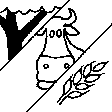
Холимог (тариалан/бэлчээр/мод), үүнд. ХАА-н ойжуулалт
- ХАА-н ойжуулалт
Гол бүтээгдэхүүн/ үйлчилгээ:
Contracted crops: Seed maize, green grams, sunflower
Surplus crops: tomatoes, vegetables, assorted fruit and tree seedlings, pepper
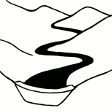
Усан зам, усан сан, ус намгархаг газар
- Усны зайлуулах шугам, усан зам
Хэрэв технологи нэвтрүүлснээр газар ашиглалтад өөрчлөлт гарсан бол технологи нэвтрүүлэхээс өмнө байсан газар ашиглалтын хэлбэрийг тодорхойлно уу:
IIchamus plain was initially a pastoral land for grazing. Being a state owned land with no one held responsible for its management, the land was poorly managed by the society.
3.3 Газар ашиглалтын тухай нэмэлт мэдээлэл
Технологи хэрэгжүүлсэн газрын усан хангамж:
- Байгалийн/усалгаатай арга хосолсон
Тайлбар:
Channeling of irrigation water into farms is restricted to dry seasons and temporarily halted during the rainy season.
Жилд ургамал ургах улирлын тоо:
- 3
Тодорхойлно уу:
The irrigation scheme is subjected to continuous cultivation with contracted crops planted in 2 seasons and a surplus crop on a third season in a year. Crop rotation and diversification is practiced to improve soil productivity, control pests, reduce soil erosion and enhance soil structure.
3.4 Технологи ГТМ-ийн аль бүлэгт хамаарах вэ
- Ээлжлэх тогтолцоо (таримал ээлжлэн тариалах, уриншлах, өнжөөн тариалах)
- Усжуулалтын менежмент (усан хангамж, ус зайлуулалт зэрэг.)
- Усны урсац зохицуулах болон салаалах
3.5 Технологийн хамрах талбай
Технологи өргөн дэлгэрсэн эсхийг тодорхойл:
- газар дээр жигд тархсан
Технологи газар нутгийн хэмжээнд жигд тархсан бол түүний эзлэх талбайг дундажаар тооцож тэмдэглэ:
- > 10,000 км2
Тайлбар:
The technology are specifically applied along the irrigation scheme with sufficient water for irrigation
3.6 Технологийг бүрдүүлэх ГТМ арга хэмжээ

Агрономийн арга хэмжээ
- А1: Ургамал/ хөрсөн бүрхэвч
- А2: Органик нэгдэл/ хөрсний үржил шим
- А5: Үрийн менежмент, сайжруулсан сорт

Ургамлын арга хэмжээ
- V3: Ургамлан нөмрөгийг хөндөх
- V4: Харийн/ түрэмгий зүйлийг солих, зайлуулах

Барилга байгууламжийн арга хэмжээ
- S2: Далан, хаалт
- S5: Далан, усан сан, цөөрөм
- S7: Ус хуримтлуулах/ усаар хангах/ усалгааны төхөөрөмж

Менежментийн арга хэмжээ
- М1: Газар ашиглалтын хэлбэрийг өөрчлөх
- M4: Үйл ажиллагааны цаг хугацаанд том өөрчлөлт орно
- M5: Төрөл зүйлийн бүтцийн өөрчлөлт/хяналт
3.7 Технологид харгалзах газрын доройтлын төрөл

хөрс усаар эвдрэх
- Wt: Хөрсний гадаргын угаагдал
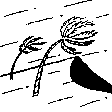
хөрс салхиар эвдрэх
- Et: Хөрсний гадаргын зөөгдөл

хөрсний химийн доройтол
- Cn: Үржил шим ба ялзмаг буурах (элэгдлийн шалтгаангүй)
- Cs: Давсжилт / шүлтжилт

биологийн доройтол
- Bh: Амьдрах орчин доройтох
- Bq: биомасс буурах
- Bs: Ургамлын чанар, төрөл зүйл, олон янз байдал буурах
- Bp: Хортон шавьж/өвчлөл ихсэх, махчид цөөрөх

усны доройтол
- Ha: Хуурайшилт
3.8 Газрын доройтлоос урьдчилан сэргийлэх, сааруулах ба нөхөн сэргээх
Газрын доройтолтой холбоотойгоор Технологи ямар зорилго тавьсан болохыг тодорхойл:
- Хүчтэй доройтсон газрыг нөхөн сэргээх/ сайжруулах
4. Техникийн нөхцөл, хэрэгжүүлсэн үйл ажиллагаа, материал ба зардал
4.1 Технологийн техник зураг
4.2 Техникийн үзүүлэлт/ техникийн зургийн тайлбар
The intake structure convey water from the main water source to the irrigation system. It may consist of a water pump or a barrier designed for this purpose. The water is directed to a conveyance system of open canals which control the flow and direction of water to different field application and distribution systems. The canals depth (h) is preferred to exceed the expected maximum water level (h){h>h1} of water within the irrigation system to minimize bank overflow. The side slope is a ratio of the vertical height to the horizontal canal width (h:w). They are fitted with water measurement, erosion and distribution control structures to regulate accurate distribution of water to the farms with minimum siltation of the banks. The water is then distributed to field ditches which transfer it to the irrigated farm. These are narrow waterways dug along the farms with checks across their lengths to hold and raise the upstream water levels long enough before releasing it to the next segment of the field ditch. This is meant to increase the rate of water infiltration into the soil.
4.3 Материал болон зардалд хамаарах ерөнхий мэдээлэл
Үнэ өртөг, оруулсан хувь нэмрийг хэрхэн тооцсоныг тодорхойл:
- Технологийн нэгж тус бүр
Нэгжийг тодорхойл:
hactares
Эзэлхүүн, урт зэргийг тодорхойл (тохиромжтой бол):
1
бусад/үндэсний мөнгөн нэгж (тодорхойл):
KES
Ам.доллар ба үндэсний мөнгөн нэгж хоорондын хөрвөх үнийг тодорхойл (шаардлагатай бол): 1 USD =:
100.0
Хөлсний ажилчны нэг өдрийн цалингийн хэмжээг тодорхойлно уу:
500
4.4 Бий болгох үйл ажиллагаа
| Үйл ажиллагаа | Арга хэмжээний төрөл | Хугацаа | |
|---|---|---|---|
| 1. | Construct gravity intake system | Барилга байгууламжийн | Once during establishment |
| 2. | Excavation of water canals | Барилга байгууламжийн | Once during establishment |
| 3. | Establishment of water control structures | Барилга байгууламжийн | Once during establishment |
| 4. | Land preparation ( Clearance and partitioning) | Барилга байгууламжийн | Once during establishment |
| 5. | Construction of a suitable road network | Барилга байгууламжийн | Once during establishment |
Тайлбар:
Activities involved are the construction of a gravity intake system, excavation of water canals, construction of a suitable road network and water control structures. Prior considerations are reliable water source, availability of irrigable land and labor for cultivation.
4.5 Бий болгоход шаардагдсан зардал, хөрөнгийн өртөг
Боломжтой бол доорхи хүснэгтийн дагуу технологийг бий болгоход гарсан зардлыг тодорхойлж, нийт болон нэгжийн өртгийг зааж өгнө үү. Хэрэв зардлыг нэр төрлөөр тодорхойлох боломжгүй бол тоймлон оруулна уу:
600000000.0
Тайлбар:
The initial establishment and construction of the irrigation infrastructure is often conducted by the national government due to associated high costs approximated by key informants to be Ksh, 600, 000,000 (600,000 USD). This is however an initial, one off expenditure that are non-recurrent.
4.6 Арчилгаа/ урсгал үйл ажиллагаа
| Үйл ажиллагаа | Арга хэмжээний төрөл | Хугацаа/ давтамж | |
|---|---|---|---|
| 1. | Clearing land | Агрономийн | 3 times a year before every planting season. |
| 2. | Ploughing | Агрономийн | 3 times a year before every planting season. |
| 3. | Ridging/Cutting furrows | Барилга байгууламжийн | 3 times a year before every planting season. |
| 4. | De-silting of canals | Менежментийн | 3 times a year before every planting season. |
| 5. | Planting | Агрономийн | 3 times a year. |
| 6. | first irrigation | Барилга байгууламжийн | 3 times a year after planting (3 to 5 days per season) |
| 7. | Pest control | Агрономийн | Whenever applicable |
| 8. | Weeding | Агрономийн | Once every season |
| 9. | Second irrigation | Барилга байгууламжийн | 10 to 12 (each time withinn 3 to 4 days) per planting season. |
| 10. | Top dressing ( Apply fertilizer) | Агрономийн | Once every season |
| 11. | Harvesting | Агрономийн | Once every season |
| 12. | Shelling | Агрономийн | Once every season |
Тайлбар:
Maintenance activities mentioned above are dependent on the status of an individual's farm, availability of resources and the purpose for cultivation. Farm produce cultivated under contracted terms will however need to follow strict procedures for them to meet the minimum requirements.
4.7 Арчилгаа/урсгал ажилд шаардагдсан зардал, хөрөнгийн өртөг (нэг жилд)
| Зардлын нэр, төрөл | Хэмжих нэгж | Тоо хэмжээ | Нэгжийн үнэ | Зардал бүрийн нийт өртөг | Нийт дүнгээс газар ашиглагчийн төлсөн % | |
|---|---|---|---|---|---|---|
| Хөдөлмөр эрхлэлт | Land clearance | Man-hour | 540.0 | 120.0 | 64800.0 | 100.0 |
| Хөдөлмөр эрхлэлт | Partitioning | Man-hour | 180.0 | 100.0 | 18000.0 | 100.0 |
| Хөдөлмөр эрхлэлт | Planting | Man-hour | 90.0 | 100.0 | 9000.0 | 100.0 |
| Тоног төхөөрөмж | Ploughing tractor | Hours | 18.0 | 420.0 | 7560.0 | 100.0 |
| Тоног төхөөрөмж | Ridging tractor | Hours | 18.0 | 420.0 | 7560.0 | 100.0 |
| таримал материал | Seeds and seedlings | Kg | 75.0 | 150.0 | 11250.0 | 100.0 |
| таримал материал | Channeling water for irrigation | Season | 3.0 | 2000.0 | 6000.0 | 100.0 |
| Бордоо ба биоцид | Fertilizer | Kg | 150.0 | 50.0 | 7500.0 | 100.0 |
| Технологийн арчилгаа/урсгал үйл ажиллагаанд шаардагдах нийт үнэ өртөг | 131670.0 | |||||
4.8 Зардалд нөлөөлж байгаа хамгийн чухал хүчин зүйл
Өртөг, зардалд нөлөөлөх гол хүчин зүйл:
Size of land
Disease and pest outbreak
Crop variety as contracted crops minimum requirements which may be costly to meet
Occurrence of rainy seasons especially during harvesting which affect the drying cost and output of produce. Seed maize, for example, may not meet the required moisture content when aired during the rainy season hence lowering the net income from them.
Condition of the farm e.g invasion level by Prosopis
5. Байгаль ба нийгмийн нөхцөл
5.1 Уур амьсгал
Жилийн нийлбэр хур тундас
- < 250 мм
- 251-500 мм
- 501-750 мм
- 751-1,000 мм
- 1,001-1,500 мм
- 1,501-2,000 мм
- 2,001-3,000 мм
- 3,001-4,000 мм
- > 4,000 мм
Жилийн дундаж хур тунадас (хэрэв мэдэгдэж байвал), мм:
671.00
Хур тунадасны талаархи тодорхойлолт/ тайлбар:
Rainfall is characterized by seasonal and annual fluctuations
Агро-уур амьсгалын бүс
- хагас хуурай
The area is in a semi-arid zone with temperatures ranging between 16 to 36 degrees, averagely 24.6 degrees, accompanied by high evaporation rates of up to 6mm. It experiences an average rainfall of 671 mm annually which are very erratic.
5.2 Гадаргын хэлбэр
Дундаж налуу:
- хавтгай (0-2 %)
- бага зэрэг налуу (3-5 %)
- дунд зэрэг налуу (6-10 % )
- хэвгий (11-15 %)
- налуу (16-30 %)
- их налуу (31-60 % )
- эгц налуу (>60 %)
Гадаргын хэлбэр:
- тэгш өндөрлөг / тал
- нуруу
- уулын энгэр
- дов толгод
- бэл
- хөндий
Өндрийн бүслүүр:
- 0-100 д.т.д. м.
- 101-500 д.т.д. м.
- 501-1,000 д.т.д м.
- 1,001-1,500 д.т.д м.
- 1,501-2,000 д.т.д м.
- 2,001-2,500 д.т.д. м.
- 2,501-3,000 д.т.д. м.
- 3,001-4,000 д.т.д м.
- > 4,000 д.т.д. м.
Технологи дараах асуудалд хандсан эсэхийг тодорхойл:
- хамааралгүй
Гадаргын талаархи тодорхойлолт ба бусад тайлбар:
The technology is applied in relatively flat land to increase water retention long enough to be infiltrated into the soil
5.3 Хөрс
Хөрсний дундаж зузаан:
- маш нимгэн (0-20 см)
- нимгэн (21-50 см)
- дунд зэрэг зузаан (51-80 см)
- зузаан (81-120 cм)
- маш зузаан (>120 cм)
Хөрсний бүтэц (өнгөн хөрс):
- нарийн /хүнд (шаварлаг)
Хөрсний бүтэц (>20 см-ээс доош):
- нарийн /хүнд (шаварлаг)
Өнгөн хөрсөнд агуулагдах ялзмаг:
- бага (<1 % )
Боломжтой бол хөрсний бүрэн тодорхойлолт, боломжит мэдээллийг өгнө үү, жишээ нь хөрсний төрөл, хөрсний урвалын орчин/хүчиллэг байдал, катион солилцох чадавхи, азотын хэмжээ, давсжилт г.м.
Clay soil with alkaline pH of 7.5 , rich in calcium phosphate but low in organic matter
5.4 Усны хүртээмж ба чанар
Гадаргын усны хүртээмж:
сайн
Усны чанар (цэвэршүүлээгүй):
зөвхөн газар тариалангийн зориулалтаар ашиглах (усалгаа)
Усны давсжилтын асуудал бий юу?
Тийм
Энэ газар үерт автдаг уу?
Тийм
5.5 Биологийн олон янз байдал
Зүйлийн олон янз байдал:
- Бага
Амьдрах орчны олон янз байдал:
- Бага
Биологийн олон янз байдлын талаархи тайлбар ба бусад тодорхойлолт:
Prosopis has heavily invaded the land, encroaching agro-pastoral land and outcompeting native species leading to degradation of native species and habitats.
5.6 Технологи нэвтрүүлсэн газар ашиглагчдын тухай мэдээлэл
Суурьшмал эсвэл нүүдлийн:
- Суурьшмал
Үйлдвэрлэлийн системийн зах зээлийн чиг баримжаа:
- холимог (амь зуух/ худалдаа наймаа
Бусад эх үүсвэрээс олох орлого:
- Нийт орлогын 10-50 %
Чинээлэг байдлын түвшин:
- ядуу
Хувь хүн эсвэл бүлэг:
- Хувь хүн / өрх
Механикжилтын түвшин:
- гар ажил
- механикжсан / мотортой
Хүйс:
- эмэгтэй
- эрэгтэй
Газар ашиглагчийн нас:
- дунд нас
- ахимаг нас
5.7 Технологи нэвтрүүлсэн газар ашиглагчийн өмчилж буй, эзэмшиж буй, түрээсэлж буй эсвэл ашиглаж буй (ашиглах эрх) газрын талбай
- < 0.5 га
- 0.5-1 га
- 1-2 га
- 2-5 га
- 5-15 га
- 15-50 га
- 50-100 га
- 100-500 га
- 500-1,000 га
- 1,000-10,000 га
- > 10,000 га
Энэ талбай том, жижиг, дунд алинд хамаарах вэ (орон нутгийн нөхцөлд харгалзуулна уу)?
- том-хэмжээний
Тайлбар:
Current land allocated by the government for the practice is an estimate of 1,800 ha. Pressure due to population increase has however triggered plans for future expansion.
5.8 Газар эзэмшил, газар ашиглах эрх, ус ашиглах эрх
Газар өмчлөл:
- төрийн
Газар ашиглах эрх:
- нэгдлийн хэлбэрээр (зохион байгуулалттай)
Ус ашиглах эрх:
- нэгдлийн хэлбэрээр (зохион байгуулалттай)
Тайлбар:
The scheme is state owned , leased to the community who nominate a 7 member advisory committee tasked with all land administration aspects ranging from land adjudication, allocation, succession and dispute management as well as set laws guiding water utilization and conservation.
5.9 Дэд бүтэц, үйлчилгээний хүртээмж
эрүүл мэнд:
- ядуу
- дунд зэргийн
- сайн
боловсрол:
- ядуу
- дунд зэргийн
- сайн
техник зөвлөгөө:
- ядуу
- дунд зэргийн
- сайн
хөдөлмөр эрхлэлт (жишээ нь, ХАА-аас өөр):
- ядуу
- дунд зэргийн
- сайн
зах зээл:
- ядуу
- дунд зэргийн
- сайн
эрчим хүчний хангамж:
- ядуу
- дунд зэргийн
- сайн
зам тээвэр:
- ядуу
- дунд зэргийн
- сайн
усан хангамж ба ариутгал:
- ядуу
- дунд зэргийн
- сайн
санхүүгийн үйлчилгээ:
- ядуу
- дунд зэргийн
- сайн
6. Үр нөлөө ба дүгнэлт
6.1 Технологийн талбайд үзүүлсэн нөлөө
Нийгэм-эдийн засгийн үр нөлөө
Үйлдвэрлэл
газар тариалангийн үйлдвэрлэл
үйлдвэрлэлийн газар
ГТМ хэрэгжихээс өмнөх тоо хэмжээ:
567 ha
ГТМ хэрэгжиснээс хойшхи тоо хэмжээ:
1,745 ha
Тайлбар/ тодорхой дурьдах:
the area developed for furrow irrigation has increased by 1,178 ha between 1958 when the operations begun to date. This is more than twice the initial land size allocated and utilized for irrigation purposes.
газрын менежмент
Тайлбар/ тодорхой дурьдах:
Development of the technology has transformed it from an open access to an organized communal tenure system with communally-designed restrictions to its access, utilization and management.
Усны хүртээмж ба чанар
мал услах усны чанар
Тайлбар/ тодорхой дурьдах:
There are chances of water pollution when contaminated irrigation water flows back to the animal watering points.
тариалангийн усалгааны усны хэрэгцээ
Тайлбар/ тодорхой дурьдах:
The progressive increase of area under cultivation as well as prolonged dry seasons over the years have culminated into increased water consumption hence a high demand for the same.
Орлого, зарлага
тухайн аж ахуйн орлого
ГТМ хэрэгжиснээс хойшхи тоо хэмжээ:
Net income of 148 192 259 million Kenya shillings
орлогын олон янз эх үүсвэр
Тайлбар/ тодорхой дурьдах:
Farming activities have diversified and increased income sources to the community who depended mainly on pastoralism. This has been enhanced by a wide variety of crops being cultivated through irrigation.
ажлын хэмжээ
Тайлбар/ тодорхой дурьдах:
Farming activities (tedious cutting, burning and uprooting of Prosopis in invaded farms, ploughing, weeding and harvesting) are all physical activities that increase the workload of the communities involved.
Экологийн үр нөлөө
Биологийн олон янз байдал: ургамал, амьтан
Ургамалын бүрхэвч
газрын дээрхи / доорхи карбон
ургамлын төрөл, зүйл
түрэмгий, харь зүйл
Тайлбар/ тодорхой дурьдах:
Irrigated land has to undergo clearance of all Invasive species, in this case, Prosopis during land preparation activities. This is carried out through a cut-burn-uproot approach to minimize chances of their proliferation. Any re-growing invasive plant is uprooted before maturity to prevent further competition for water and nutrient with cultivated crops. Chances of re-invasion are also minimized as land is never left idle for colonization by Prosopis. This has greatly decreased invasive cover on irrigated land.
Уур амьсгал болон гамшгийн эрсдлийг бууруулах
гангийн нөлөө
Тайлбар/ тодорхой дурьдах:
Drought related impacts such as malnutrition, famine and death have been reduced by irrigation practices which increases food insecurity independent of the season.
6.2 Технологийн талбайн гадна үзүүлсэн үр нөлөө
Усны хүртээмж
Тайлбар/ тодорхой дурьдах:
Diversion of water into open channels for irrigation reduce the downstream flow for offsite usage downstream.
голын адагт үерлэх
Тайлбар/ тодорхой дурьдах:
Potential flood water are diverted to farms hence reducing downstream flooding. However, this impact may not be significant during heavy downpours where diversion valves are closed to prevent unnecessary water logging on farmlands.
6.3 Технологийн уур амьсгалын өөрчлөлт, цаг агаарын гамшигт үзэгдэлд өртөх байдал ба эмзэг байдал (газар ашиглагчийн бодлоор)
Уур амьсгалын аажим өөрчлөлт
Уур амьсгалын аажим өөрчлөлт
| Улирал | Уур амьсгалын өөрчлөлт/экстрим үзэгдлийн төрөл | Технологи түүний нөлөөг хэрхэн бууруулж байна? | |
|---|---|---|---|
| улирлын хур тундас | чийглэг/борооны улирал | Өсөлт | дунд зэрэг |
Уур амьсгалаас хамаарах аюул (гамшиг)
Биологийн гамшиг
| Технологи түүний нөлөөг хэрхэн бууруулж байна? | |
|---|---|
| цар тахал | маш муу |
| шавьж / хорхойн олшрол | маш муу |
6.4 Өртөг ба ашгийн шинжилгээ
Бий болгох зардалтай харьцуулахад ямар ашиг өгсөн бэ (газар ашиглагчийн бодлоор)?
Богино хугацаанд эргэн төлөгдөх байдал:
бага зэрэг эерэг
Урт хугацаанд эргэн төлөгдөх байдал:
эерэг
Арчилгаа/урсгал зардалтай харьцуулахад ямар ашиг өгсөн бэ (газар ашиглагчийн бодлоор)?
Богино хугацаанд эргэн төлөгдөх байдал:
бага зэрэг эерэг
Урт хугацаанд эргэн төлөгдөх байдал:
эерэг
6.5 Технологи нэвтрүүлэлт
- 1-10 %
Боломжтой бол, тоогоор илэрхийл (өрхийн тоо эсвэл бүрхэх талбай):
Direct beneficiaries of the technologies are about 13,000 people. However, indirect beneficiaries from the transportation and sale of the produce may double this number
Технологи нэвтрүүлсэн хүмүүсээс хэд нь өөрийн хүчээр технологийг хэрэгжүүлсэн бэ, өөрөөр хэлбэл гадны тусламж дэмжлэг авалгүйгээр?
- 90-100 %
Тайлбар:
All operation are carried out at the full expense of the land users. Credits advanced to them have to be repaid with at least 11% interest
6.6 Дасан зохицох
Бий болсон өөрчлөлтөд зохицуулан технологийг өөрчилсөн үү?
Тийм
Хэрэв Тийм бол ямар өөрчлөлтөд дасан зохицсон бэ:
- уур амьсгалын өөрчлөлт/ экстрим үзэгдэл
Дасан зохицох зорилгоор технологид хийсэн өөрчлөлт (хийц, материал, төрөл зүйл г.м.):
Water conveyance along the furrows to the farms is halted during heavy downpour to minimize water logging.
6.7 Технологийн давуу тал/боломжууд
| Газар ашиглагчдын тодорхойлсон давуу тал/боломжууд |
|---|
| A source of finance to land users through sale of their produce. |
| Эмхэтгэгч, бусад мэдээлэл өгсөн хүмүүсийн өнцгөөс тодорхойлсон давуу тал/боломжууд |
|---|
| Continuous farming activities have ensured that land is constantly managed, limiting the proliferation of Prosopis weeds which have adverse impacts to the ecosystem and livelihoods. |
| Improved human welfare by enhancing their financial stability. An extension of this is indirect benefit through employment creation to farm laborers, merchants and buyers of the fresh and healthy farm produce. |
| Increased food security |
6.8 Технологийн дутагдалтай/сул тал/аюул болон тэдгээрийг хэрхэн даван туулах арга зам
| Газар ашиглагч нарын тодорхойлсон сул тал/ дутагдал/ эрсдэл | Тэдгээрийг хэрхэн даван туулах вэ? |
|---|---|
| Poor market prices for their produce. | They feel they have no option due to inadequate knowledge and access to other available markets |
| Pests and disease out break such as the fall armyworm. | Advisory services are offered by research institutions to stakeholders on how to manage and control pests. |
| Эмхэтгэгч, бусад мэдээлэл өгсөн хүмүүсийн өнцгөөс тодорхойлсон сул тал/ дутагдал/ эрсдэл | Тэдгээрийг хэрхэн даван туулах вэ? |
|---|---|
| Monopoly of the market by the contracting institutions may lead to poor pricing or tight minimum requirements such as the quality of output leading to losses. | Diversification of market to tighten competition that may offer better prices to farmers. |
| High chances of water pollution by chemicals and fertilizers that may be washed away by the running water | Minimize application of chemicals as possible accompanied by integrated nutrient management practices. |
| Post harvest losses when supply exceeds demand | Proper timing of planting season whereby harvesting coincides with seasons of shortage and scarcity to maximize returns. |
7. Ном зүй ба холбоосууд
7.1 Мэдээлэл цуглуулсан арга/эх үүсвэр
- Хээрийн уулзалт, судалгаа
2
- Газар ашиглагчтай хийсэн ярилцлага
2
- ГТМ-ийн мэргэжилтэн/шинжээчтэй хийсэн ярилцлага
3
- тайлан болон бусад эх сурвалжийн бүрдэл
2
7.2 Ном, хэвлэлийн ишлэл
Гарчиг, зохиогч, он, ISBN:
Brouwer, C., Goffeau, A., and Heibloem, M. (1985): Irrigation Water Management: Training Manual No. 1
Хаанаас авч болох вэ? Зардал?
http://www.fao.org/docrep/r4082e/r4082e00.htm#Contents
7.3 Цахимаар олж болох хэвлэлийн холбоос (ж.нь ном, тайлан, видео г.м.)
Гарчиг/ тодорхойлолт:
Perkerra Irrigation scheme Brief
URL:
https://www.nib.or.ke/projects/public-irrigation-schemes/perkerra-irrigation-scheme
Гарчиг/ тодорхойлолт:
The 9 Benefits of Crop Rotation to the Environment
URL:
http://richmondvale.org/crop-rotation/
Холбоос ба модулууд
Бүгдийг дэлгэх Бүгдийг хаахХолбоосууд
Холбоос байхгүй байна
Модулууд
Модуль байхгүй байна


